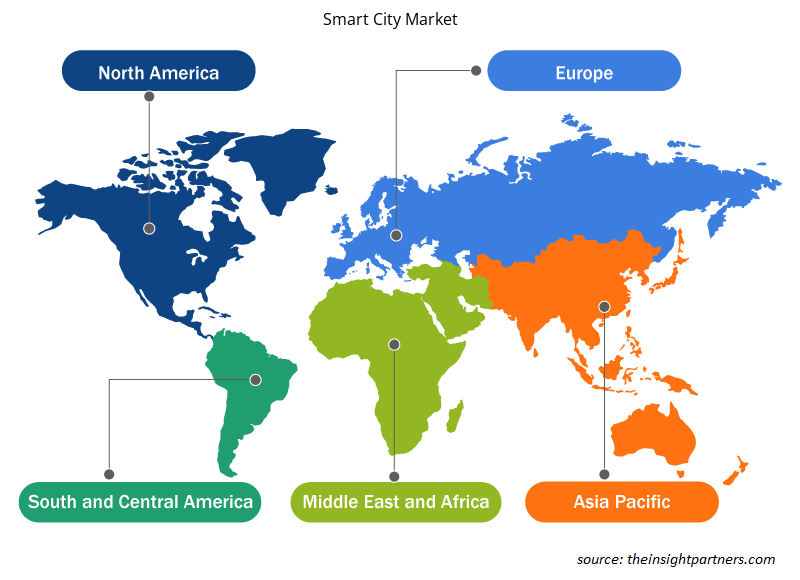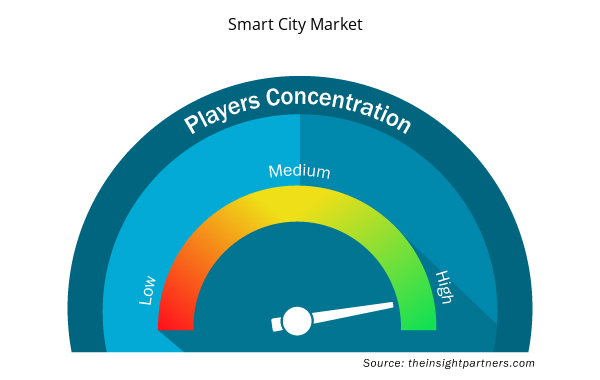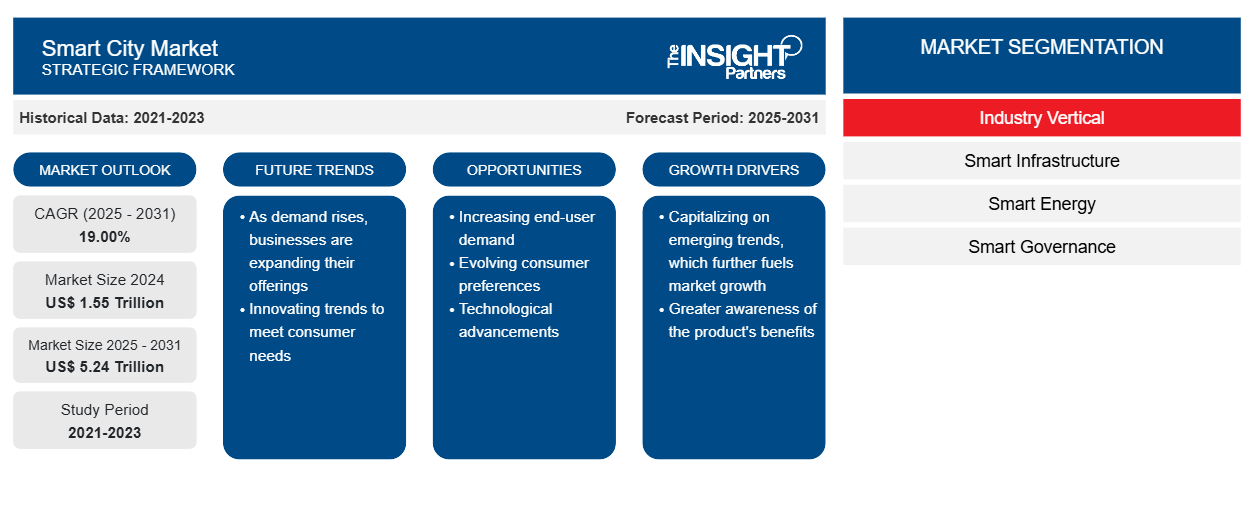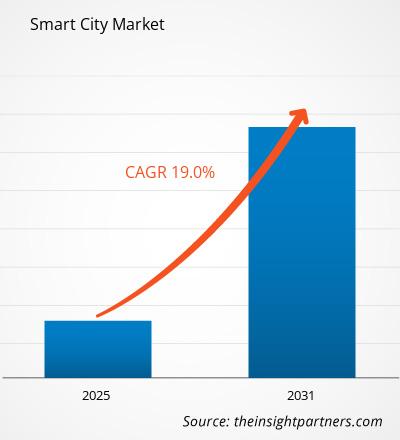Der Smart-City-Markt soll von 1.094,23 Milliarden US-Dollar im Jahr 2022 auf 3.110,58 Milliarden US-Dollar im Jahr 2031 wachsen; von 2022 bis 2031 wird mit einer durchschnittlichen jährlichen Wachstumsrate von 19,0 % gerechnet.
Smart Cities sind ein Konzept, bei dem verschiedene Aspekte einer Stadt oder Provinz auf fortschrittlichen Technologien basieren. Diese Städte nutzen digitale Technologien und das Internet, um die Leistung von Dienstleistungen und die Lebensqualität zu verbessern, indem sie Energie optimieren und die Sicherheit für die Bürger verbessern. Das Smart-City-Konzept zielt darauf ab, robuste Konnektivität und Infrastruktur zu entwickeln, um Echtzeit-Informationszugriff für den Aufbau eines Managementsystems zu ermöglichen, das Bürger, Dienstleister und Administratoren effizient verbindet. Darüber hinaus stellt die Regierung sicher, dass die Einwohner aktiv an der Verbesserung der allgemeinen Nachhaltigkeit und Produktivität von Dienstleistungen teilnehmen, indem sie die Städte mit elementarer Infrastruktur ausstattet.
Die Technologie für intelligente Infrastrukturen hat sich im Laufe der Zeit erheblich verändert, und verschiedene Bereiche wie Gebäudeautomation für das Anlagen- und Notfallmanagement, Gebäudeenergieoptimierung, Parkraummanagement und Gebäudekommunikationssysteme werden heute weithin übernommen. Darüber hinaus sind in vielen Ländern, insbesondere in Europa, Nordamerika und der Region Asien-Pazifik, Initiativen für umweltfreundliches Bauen in den Mittelpunkt gerückt. Der Fokus auf die Reduzierung des Energieverbrauchs und die Sorge um die Zunahme von Umweltabfällen sind die wichtigsten Antriebsfaktoren für die Entwicklung intelligenter Städte. Der Verkehr wird im Prognosezeitraum für den Smart-City-Markt voraussichtlich ein weiterer wichtiger Schwerpunkt sein.
Passen Sie diesen Bericht Ihren Anforderungen an
Sie erhalten kostenlos individuelle Anpassungen an jedem Bericht, einschließlich Teilen dieses Berichts oder einer Analyse auf Länderebene, eines Excel-Datenpakets sowie tolle Angebote und Rabatte für Start-ups und Universitäten.
- Holen Sie sich die wichtigsten Markttrends aus diesem Bericht.Dieses KOSTENLOSE Beispiel umfasst eine Datenanalyse von Markttrends bis hin zu Schätzungen und Prognosen.
Die Erschöpfung der Energiequellen und die ineffiziente Ressourcenverwaltung werden weltweit zunehmend zu großen Problemen. Dies treibt die Nachfrage nach intelligenten Energielösungen auf der ganzen Welt voran. Intelligente Energiemanagementsysteme verwenden Sensoren, moderne Messgeräte, erneuerbare Energiequellen , digitale Steuerungen und Analysetools, um die Energieverteilung und -nutzung zu automatisieren, zu überwachen und zu optimieren. Solche Systeme optimieren den Netzbetrieb und die Netznutzung, indem sie die Bedürfnisse der verschiedenen beteiligten Interessengruppen (Verbraucher, Produzenten und Anbieter) in Einklang bringen. Es gibt mehrere Innovationen in der intelligenten Energieinfrastruktur, wie z. B. die dezentrale Erzeugung erneuerbarer Energien, Mikronetze, Smart-Grid-Technologien, Energiespeicherung, automatisierte Nachfragereaktion, virtuelle Kraftwerke und nachfrageseitige Innovationen wie Elektrofahrzeuge und intelligente Haushaltsgeräte. Solche Innovationen bieten ein erweitertes Netzwerk intelligenter Energiegeräte in einer Stadt mit einer detaillierten Ansicht der Energieverbrauchsmuster, ermöglichen gemeinschaftsbasierte Energieüberwachungsprogramme und verbessern die Energieeffizienz von Gebäuden.
Regionale Analyse des Smart City-Marktes
Aus regionaler Sicht hatte Nordamerika im Jahr 2021 den größten Anteil am globalen Smart-City-Markt. Die hohe Akzeptanz technologisch fortschrittlicher Lösungen in allen Industriezweigen der Region trägt zum Wachstum des nordamerikanischen Smart-City-Marktes bei. Die zunehmende staatliche Unterstützung der Technologieeinführung durch die Ankündigung von Subventionen, Steuergutschriften und Finanzmitteln für die technologische Entwicklung der Industrie katalysiert den Markt weiter und bietet damit den in der gesamten Region tätigen Smart-City-Marktakteuren lukrative Geschäftsmöglichkeiten. So kündigte die US-Bundesregierung im November 2021 im Rahmen des Infrastructure Investment and Jobs Act eine Finanzierung in Höhe von 500 Millionen US-Dollar an, um die Herausforderungen der Smart Cities zu bewältigen. Darüber hinaus treibt die Präsenz mehrerer Smart-City-Marktakteure in der gesamten Region, die sich ständig um Innovation und Produktentwicklung bemühen, den nordamerikanischen Smart-City-Markt weiter an.
Markteinblicke – Smart City-Markt
Branchenspezifische Einblicke
Basierend auf den Branchenvertikalen ist der Smart-City-Markt in intelligente Infrastruktur , intelligente Energie, intelligente Verwaltung, intelligenten Verkehr, intelligentes Gesundheitswesen und intelligente Bildung segmentiert. Das Segment intelligenter Verkehr wird im Prognosezeitraum voraussichtlich die höchste durchschnittliche jährliche Wachstumsrate aufweisen. Intelligenter Verkehr ist eine innovative Verkehrs- und Mobilitätsinfrastruktur, die auf neuen Technologien basiert und darauf ausgelegt ist, Ressourcen zu sparen und für maximale Effizienz zu sorgen. Der Einsatz von Schlüsseltechnologien wie Cloud Computing , 4G, maschinelles Lernen und Operationen in neuartigen Projekten wird voraussichtlich häufiger in intelligenten Transportsystemen wie der Eisenbahn angewandt werden und weltweit effiziente Personen- und Gütertransportdienste bieten, wodurch ein Pool von Möglichkeiten für zahlreiche Branchenakteure im Ökosystem der intelligenten Städte entsteht. Dies würde auch verschiedene Kapitalisten und Investoren anziehen und zu einem enormen Wachstum des Marktes für intelligenten Verkehr führen.
Regionale Einblicke zum Smart City-Markt
Die regionalen Trends und Faktoren, die den Smart City-Markt im Prognosezeitraum beeinflussen, wurden von den Analysten von Insight Partners ausführlich erläutert. In diesem Abschnitt werden auch die Marktsegmente und die Geografie des Smart City-Marktes in Nordamerika, Europa, im asiatisch-pazifischen Raum, im Nahen Osten und Afrika sowie in Süd- und Mittelamerika erörtert.

- Holen Sie sich regionale Daten zum Smart City-Markt
Umfang des Smart City-Marktberichts
| Berichtsattribut | Details |
|---|---|
| Marktgröße im Jahr 2023 | 1,30 Billionen US-Dollar |
| Marktgröße bis 2031 | 5,24 Billionen US-Dollar |
| Globale CAGR (2023 - 2031) | 19,00 % |
| Historische Daten | 2021-2022 |
| Prognosezeitraum | 2024–2031 |
| Abgedeckte Segmente | Nach Branchenvertikale
|
| Abgedeckte Regionen und Länder | Nordamerika
|
| Marktführer und wichtige Unternehmensprofile |
|
Marktteilnehmerdichte: Der Einfluss auf die Geschäftsdynamik
Der Smart City-Markt wächst rasant, angetrieben durch die steigende Nachfrage der Endnutzer aufgrund von Faktoren wie sich entwickelnden Verbraucherpräferenzen, technologischen Fortschritten und einem größeren Bewusstsein für die Vorteile des Produkts. Mit steigender Nachfrage erweitern Unternehmen ihr Angebot, entwickeln Innovationen, um die Bedürfnisse der Verbraucher zu erfüllen, und nutzen neue Trends, was das Marktwachstum weiter ankurbelt.
Die Marktteilnehmerdichte bezieht sich auf die Verteilung der Firmen oder Unternehmen, die in einem bestimmten Markt oder einer bestimmten Branche tätig sind. Sie gibt an, wie viele Wettbewerber (Marktteilnehmer) in einem bestimmten Marktraum im Verhältnis zu seiner Größe oder seinem gesamten Marktwert präsent sind.
Die wichtigsten auf dem Smart City-Markt tätigen Unternehmen sind:
- ABB Ltd.
- Accenture
- Cisco
- Ericsson
- Schneider Electric
- GE
Haftungsausschluss : Die oben aufgeführten Unternehmen sind nicht in einer bestimmten Reihenfolge aufgeführt.

- Überblick über die wichtigsten Akteure auf dem Smart City-Markt
Die Akteure auf dem Smart-City-Markt konzentrieren sich hauptsächlich auf die Entwicklung fortschrittlicher und effizienter Produkte.
- Im Oktober 2021 gab die Siemens AG die Übernahme von Squills bekannt. Diese Übernahme stärkte die Mobilitätslösungen des Unternehmens, wie etwa Reservierungs- und Ticketing-Software.
- Im Mai 2021 sind Microsoft Corporation und Itron Inc eine strategische Partnerschaft eingegangen, um ihren Kunden gemeinsam hochentwickelte Dienste zur Verwaltung mobiler Geräte (Mobile Device Management, MDM) anzubieten.
Der Smart-City-Markt ist in fünf große Regionen unterteilt: Nordamerika, Europa, Asien-Pazifik (APAC), Naher Osten und Afrika sowie Südamerika. Im Jahr 2022 war Nordamerika mit einem beträchtlichen Umsatzanteil Marktführer, gefolgt von Europa. Darüber hinaus wird erwartet, dass der Asien-Pazifik-Raum von 2022 bis 2031 die höchste durchschnittliche jährliche Wachstumsrate im Smart-City-Markt verzeichnet.
Zu den wichtigsten globalen Akteuren auf dem Smart City-Markt zählen ABB Ltd; Cisco Systems, Inc.; Oracle Corporation; Microsoft Corporation; und IBM Corporation. Darüber hinaus wurden im Rahmen der Studie mehrere andere Akteure analysiert, darunter Accenture, General Electric Company, Schneider Electric SE, Siemens AG und Ericsson AB.
- Historische Analyse (2 Jahre), Basisjahr, Prognose (7 Jahre) mit CAGR
- PEST- und SWOT-Analyse
- Marktgröße Wert/Volumen – Global, Regional, Land
- Branche und Wettbewerbsumfeld
- Excel-Datensatz


- Mobile Phone Insurance Market
- Integrated Platform Management System Market
- Frozen Potato Market
- Enzymatic DNA Synthesis Market
- Medical Enzyme Technology Market
- Authentication and Brand Protection Market
- Visualization and 3D Rendering Software Market
- Smart Locks Market
- Fishing Equipment Market
- Aesthetic Medical Devices Market

Report Coverage
Revenue forecast, Company Analysis, Industry landscape, Growth factors, and Trends

Segment Covered
This text is related
to segments covered.

Regional Scope
North America, Europe, Asia Pacific, Middle East & Africa, South & Central America

Country Scope
This text is related
to country scope.
Trends and growth analysis reports related to Electronics and Semiconductor : READ MORE..
The List of Companies - Smart Cities Market
- ABB Ltd.
- Accenture
- Cisco
- Ericsson
- Schneider Electric
- GE
- Microsoft
- IBM Corporation
- Oracle
- Siemens
The Insight Partners performs research in 4 major stages: Data Collection & Secondary Research, Primary Research, Data Analysis and Data Triangulation & Final Review.
- Data Collection and Secondary Research:
As a market research and consulting firm operating from a decade, we have published and advised several client across the globe. First step for any study will start with an assessment of currently available data and insights from existing reports. Further, historical and current market information is collected from Investor Presentations, Annual Reports, SEC Filings, etc., and other information related to company’s performance and market positioning are gathered from Paid Databases (Factiva, Hoovers, and Reuters) and various other publications available in public domain.
Several associations trade associates, technical forums, institutes, societies and organization are accessed to gain technical as well as market related insights through their publications such as research papers, blogs and press releases related to the studies are referred to get cues about the market. Further, white papers, journals, magazines, and other news articles published in last 3 years are scrutinized and analyzed to understand the current market trends.
- Primary Research:
The primarily interview analysis comprise of data obtained from industry participants interview and answers to survey questions gathered by in-house primary team.
For primary research, interviews are conducted with industry experts/CEOs/Marketing Managers/VPs/Subject Matter Experts from both demand and supply side to get a 360-degree view of the market. The primary team conducts several interviews based on the complexity of the markets to understand the various market trends and dynamics which makes research more credible and precise.
A typical research interview fulfils the following functions:
- Provides first-hand information on the market size, market trends, growth trends, competitive landscape, and outlook
- Validates and strengthens in-house secondary research findings
- Develops the analysis team’s expertise and market understanding
Primary research involves email interactions and telephone interviews for each market, category, segment, and sub-segment across geographies. The participants who typically take part in such a process include, but are not limited to:
- Industry participants: VPs, business development managers, market intelligence managers and national sales managers
- Outside experts: Valuation experts, research analysts and key opinion leaders specializing in the electronics and semiconductor industry.
Below is the breakup of our primary respondents by company, designation, and region:

Once we receive the confirmation from primary research sources or primary respondents, we finalize the base year market estimation and forecast the data as per the macroeconomic and microeconomic factors assessed during data collection.
- Data Analysis:
Once data is validated through both secondary as well as primary respondents, we finalize the market estimations by hypothesis formulation and factor analysis at regional and country level.
- Macro-Economic Factor Analysis:
We analyse macroeconomic indicators such the gross domestic product (GDP), increase in the demand for goods and services across industries, technological advancement, regional economic growth, governmental policies, the influence of COVID-19, PEST analysis, and other aspects. This analysis aids in setting benchmarks for various nations/regions and approximating market splits. Additionally, the general trend of the aforementioned components aid in determining the market's development possibilities.
- Country Level Data:
Various factors that are especially aligned to the country are taken into account to determine the market size for a certain area and country, including the presence of vendors, such as headquarters and offices, the country's GDP, demand patterns, and industry growth. To comprehend the market dynamics for the nation, a number of growth variables, inhibitors, application areas, and current market trends are researched. The aforementioned elements aid in determining the country's overall market's growth potential.
- Company Profile:
The “Table of Contents” is formulated by listing and analyzing more than 25 - 30 companies operating in the market ecosystem across geographies. However, we profile only 10 companies as a standard practice in our syndicate reports. These 10 companies comprise leading, emerging, and regional players. Nonetheless, our analysis is not restricted to the 10 listed companies, we also analyze other companies present in the market to develop a holistic view and understand the prevailing trends. The “Company Profiles” section in the report covers key facts, business description, products & services, financial information, SWOT analysis, and key developments. The financial information presented is extracted from the annual reports and official documents of the publicly listed companies. Upon collecting the information for the sections of respective companies, we verify them via various primary sources and then compile the data in respective company profiles. The company level information helps us in deriving the base number as well as in forecasting the market size.
- Developing Base Number:
Aggregation of sales statistics (2020-2022) and macro-economic factor, and other secondary and primary research insights are utilized to arrive at base number and related market shares for 2022. The data gaps are identified in this step and relevant market data is analyzed, collected from paid primary interviews or databases. On finalizing the base year market size, forecasts are developed on the basis of macro-economic, industry and market growth factors and company level analysis.
- Data Triangulation and Final Review:
The market findings and base year market size calculations are validated from supply as well as demand side. Demand side validations are based on macro-economic factor analysis and benchmarks for respective regions and countries. In case of supply side validations, revenues of major companies are estimated (in case not available) based on industry benchmark, approximate number of employees, product portfolio, and primary interviews revenues are gathered. Further revenue from target product/service segment is assessed to avoid overshooting of market statistics. In case of heavy deviations between supply and demand side values, all thes steps are repeated to achieve synchronization.
We follow an iterative model, wherein we share our research findings with Subject Matter Experts (SME’s) and Key Opinion Leaders (KOLs) until consensus view of the market is not formulated – this model negates any drastic deviation in the opinions of experts. Only validated and universally acceptable research findings are quoted in our reports.
We have important check points that we use to validate our research findings – which we call – data triangulation, where we validate the information, we generate from secondary sources with primary interviews and then we re-validate with our internal data bases and Subject matter experts. This comprehensive model enables us to deliver high quality, reliable data in shortest possible time.


 Holen Sie sich ein kostenloses Muster für diesen Bericht
Holen Sie sich ein kostenloses Muster für diesen Bericht